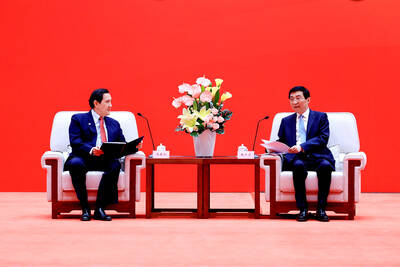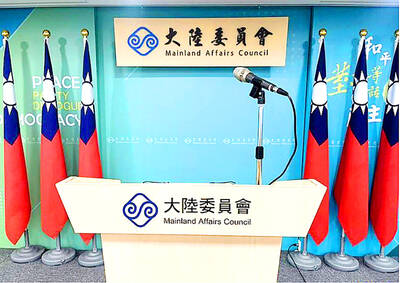With about two weeks left before Chinese free independent travelers (FIT) are allowed to visit Taiwan, travel agents yesterday said they were still unclear about the regulations governing applications for travel permits on behalf of the Chinese visitors.
Chinese National Tourism Administration Director Shao Qiwei (邵琪偉) told the annual Straits Forum, which opened in Xiamen, Fujian Province, yesterday, that Chinese FITs would be able to start touring Taiwan from June 28.
According to the forum’s official Web site, Shao said tourists from Beijing, Shanghai and Xiamen would be the first to be allowed to travel independently during a trial period for the FIT program.
Shao said Taiwan and China had agreed that residents in Fujian Province would be permitted to travel to Taiwan’s outlying islands — Kinmen, Matsu and Penghu.
It remains unclear whether Green Island (綠島), Taitung County, will be included, as reports last week said the Chinese government had removed the island from its list of package tours because of the presence of anti-communist slogans, which some Chinese tourists have reportedly found “offensive.”
Following Shao’s announcement, the Ministry of Transportation and Communications and the Tourism Bureau said they had yet to receive all the relevant information on the matter.
The Mainland Affairs Council said it would not comment on Shao’s remarks. However, it said the goal of launching the FIT program at the end of this month remained unchanged.
Travel agents said they welcomed the announcement and were ready to greet the FITs.
However, Travel Agent Association of ROC, Taiwan (中華民國旅行商業同業公會全國聯合會) secretary--general Roget Hsu (許高慶) said most travel agents were still unfamiliar with the regulations concerning the application for travel permits on behalf of Chinese FITs.
“In its presentation to travel agents on Friday, the National Immigration Agency did not say whether the application should also include travel insurance and SIM cards for emergency use only,” Hsu said. “Should the agency decide to issue electronic visas, does that mean it will be solely -responsible for reviewing and approving the applications? All these questions remain unanswered.”
Some travel agents also criticized the agency’s plan to make them guarantors for Chinese FITs in case they overstay their 15-day visas or abscond.
The package tours Chinese FITs will be able to purchase from airlines, as well as the itineraries enclosed in travel permit applications, generally do not contain many details, they said. As a result, it is virtually impossible for local travel agents to guarantee that Chinese FITs will not overstay their visas.
Under the current framework for the program, a daily maximum of 500 independent Chinese tourists will be allowed to enter the country.
ADDITIONAL REPORTING BY STAFF WRITER

CHIP WAR: The new restrictions are expected to cut off China’s access to Taiwan’s technologies, materials and equipment essential to building AI semiconductors Taiwan has blacklisted Huawei Technologies Co (華為) and Semiconductor Manufacturing International Corp (SMIC, 中芯), dealing another major blow to the two companies spearheading China’s efforts to develop cutting-edge artificial intelligence (AI) chip technologies. The Ministry of Economic Affairs’ International Trade Administration has included Huawei, SMIC and several of their subsidiaries in an update of its so-called strategic high-tech commodities entity list, the latest version on its Web site showed on Saturday. It did not publicly announce the change. Other entities on the list include organizations such as the Taliban and al-Qaeda, as well as companies in China, Iran and elsewhere. Local companies need

CRITICISM: It is generally accepted that the Straits Forum is a CCP ‘united front’ platform, and anyone attending should maintain Taiwan’s dignity, the council said The Mainland Affairs Council (MAC) yesterday said it deeply regrets that former president Ma Ying-jeou (馬英九) echoed the Chinese Communist Party’s (CCP) “one China” principle and “united front” tactics by telling the Straits Forum that Taiwanese yearn for both sides of the Taiwan Strait to move toward “peace” and “integration.” The 17th annual Straits Forum yesterday opened in Xiamen, China, and while the Chinese Nationalist Party’s (KMT) local government heads were absent for the first time in 17 years, Ma attended the forum as “former KMT chairperson” and met with Chinese People’s Political Consultative Conference Chairman Wang Huning (王滬寧). Wang

CROSS-STRAIT: The MAC said it barred the Chinese officials from attending an event, because they failed to provide guarantees that Taiwan would be treated with respect The Mainland Affairs Council (MAC) on Friday night defended its decision to bar Chinese officials and tourism representatives from attending a tourism event in Taipei next month, citing the unsafe conditions for Taiwanese in China. The Taipei International Summer Travel Expo, organized by the Taiwan Tourism Exchange Association, is to run from July 18 to 21. China’s Taiwan Affairs Office spokeswoman Zhu Fenglian (朱鳳蓮) on Friday said that representatives from China’s travel industry were excluded from the expo. The Democratic Progressive Party government is obstructing cross-strait tourism exchange in a vain attempt to ignore the mainstream support for peaceful development

DEFENSE: The US would assist Taiwan in developing a new command and control system, and it would be based on the US-made Link-22, a senior official said The Ministry of National Defense is to propose a special budget to replace the military’s currently fielded command and control system, bolster defensive resilience and acquire more attack drones, a senior defense official said yesterday. The budget would be presented to the legislature in August, the source said on condition of anonymity. Taiwan’s decade-old Syun An (迅安, “Swift Security”) command and control system is a derivative of Lockheed Martin’s Link-16 developed under Washington’s auspices, they said. The Syun An system is difficult to operate, increasingly obsolete and has unresolved problems related to integrating disparate tactical data across the three branches of the military,